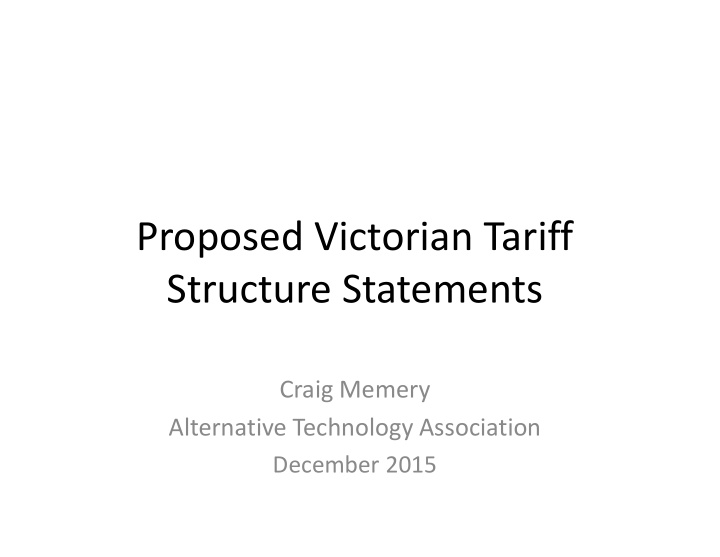



Proposed Victorian Tariff Structure Statements Craig Memery Alternative Technology Association December 2015
About ATA • Not for profit, community organisation • Established 1980 • 6,000 members, mostly households • 14 member-run branches • Australia’s largest green publisher • Energy projects to tackle poverty • Energy policy and research • Advocacy for Australian energy users
ATA and cost reflective network pricing ATA supports moving to cost reflective pricing structures, with opportunities for consumers to respond, when supported by robust protections for disadvantaged and vulnerable consumers. • Engaged with Power of Choice reforms • Engaged with AEMC and others in the network pricing rule change process in 2013/14 • Engaging with networks, AER etc to influence TSS proposals and approvals in 2015/16 • Next project: TSS report card • With support of CAP and ECA
Our 2015/16 TSS project • Engaging with 12 DNSPs, AER, Govts, others • Participating in stakeholder workshops/forums • Bilateral meetings to explore issues in depth • Written submissions to DSNPs and AER • Building capacity and collaborating with other consumer advocates (and other stakeholders) • Researching consumer impacts and preferences
New pricing rules strike right balance • Reduce cross subsidies, send the right signals • Long Run Marginal Cost principle promotes – Dropping energy (kWh) charges – Seasonal peak demand (kW) charges – Higher fixed charges • While the consumer impact principle promotes – Slow transition from kWh charges – Spreading/smearing seasonal kW charges – Lower fixed charges
How have networks responded? • Victorian networks proposing to phase in peak demand charges with (3 to 9pm working day) peak window for households from 2017/18 • New South Wales networks proposing declining block tariffs (how long have you got?) • Other networks proposing – voluntary peak demand charges for this TSS – aspirational goal of mandatory charges longer term (some longer than others)
Victorian TSS proposals - positives • Common peak tariff window – Consistency for households, retailers – Simpler messaging and education – Perception is important • Good timing lessens negative impacts – Low LRMC means (relatively) low (foreseeable) distributional impact of peak kW charging – Lower revenue (subject to final determination and appeals) helps mitigate negative impacts overall • Some great stakeholder engagement
Victorian TSS proposals - issues • Any proposed increase to a fixed charge is unacceptable, given lower revenue risk under cost reflective charging and revenue cap. • Bill shock/volatility could be better addressed • 9pm finish to peak period: is it too late? • Lack of options for voluntary ‘more cost reflective’ tariffs for engaged consumers • Some less-than-great stakeholder engagement
Victorian TSS proposals - tradeoffs • Common tariff requires an (acceptable) trade off with cost-reflexivity in parts of network that – Peak on weekends (or public holidays) – Peak before 3pm on weekdays – Peak in winter The alternative? Excessive peak periods • We need to address by next TSS: – Should we move to locational pricing? – Can we shorten the peak window?
In conclusion ATA supports moving to cost reflective pricing structures, with opportunities for consumers to respond, when supported by robust protections for disadvantaged and vulnerable consumers. Overall, the proposed Victorian Tariff Structure Statements meet these criteria (in context), with minor specific room for improvement.
(Some of) the bigger questions on cost reflective network tariffs • Will jurisdictional arrangements or nervous governments stall the reforms? • Will the AER accept (NNSW) more creative interpretation of the rules? • Will retailers pass through the price signal? • Does it matter if they don’t? • Will consumers respond to signals en masse? • Does it matter if they don’t?
Recommend
More recommend